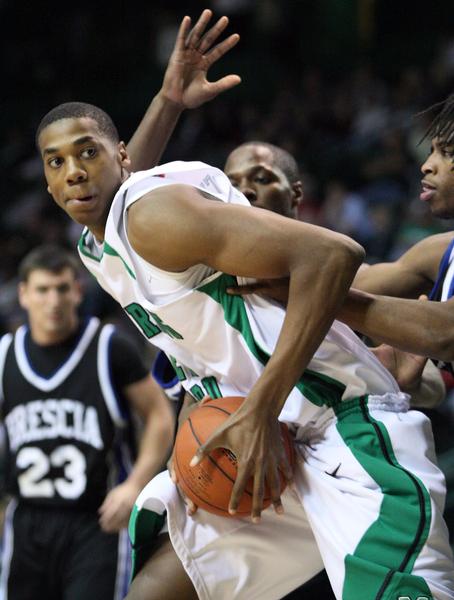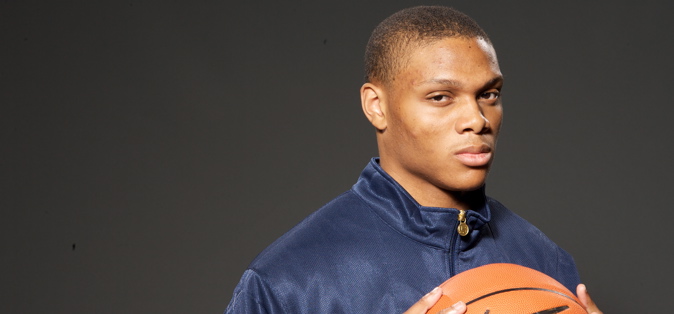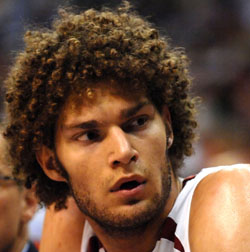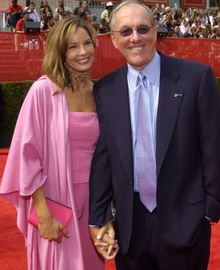Posted by rtmsf on June 5th, 2007
Thanks to the guys over at draftexpress.com, we’re just getting our first look at some of the height/weight and athletic numbers coming out of the NBA Predraft Camp last weekend in Orlando. We don’t put a lot of stock in drafting players based on these measurements – after all, if a guy can play, he can play (tip of the hat to Jonathan Givony for making this very point perfectly on draftexpress.com) – but it’s always fun to see who wins for the “incredible shrinking” award (aka the Lonny Baxter Trophy) as well as who appears to be the top athletes coming out of college this year. Note we said “appears.”

The Logo and MJ discussing the talent in Orlando
Why wasn’t Maryland better this year?
Guard D.J. Strawberry was rated the top overall athlete this year, and Ekene Ibekwe had some of the most eye-popping big man numbers, featuring a 7’6 foot wingspan and a thirty-nine inch veritical leap. This is yet another example of superior basketball skills and IQ (see: Florida Gators) trumping a stable of athletes. Either that, or Gary Williams was too busy resting on his laurels to teach these kids anything the last four years.
Durant needs to beef up
We realize he’s only eighteen and he can score on just about anyone already… but zero bench presses of 185 lbs. is pathetic. That stat, combined with his surprising lack of speed and agility in the drills, may suggest that he’ll face long obstacles in becoming a solid two-way player in the long run. He’s also going to take a beating on drives into the paint the next few years unless he commits himself to a weight training program to improve his strength.
Perhaps not surpisingly, most of the one-and-dones were weaker than their older peers. Durant, Julian Wright (2), Brandan Wright (2) and Daequan Cook (4) combined for a total of just eight bench presses at the 185-lb. weight. Mike Conley, Jr., (13), Javaris Crittenton (11) and Spencer Hawes (9) did better. Greg Oden sat out that event due to his injured wrist.
Lonny Baxter Award
Corey Brewer. Routinely listed at 6’9 at Florida, he came in at just 6’6.75 by the camp measurements. Lucky for him, he’s not a post man, so this won’t likely affect his draft status too much. Another Floridian, Al Thornton, deserves a nod here too. FSU listed him at 6’8, but the measurements put him at a mere 6’5.75. Considering that Thornton logged significant minutes on the interior, this puts him at a major disadvantage going into the draft.
Who Knew?
Aaron Gray is a legitimate seven feet tall, and Joakim Noah is a solid 6’10.5. We would have guessed both were shorter. ACC bigs Brandan Wright and Josh McRoberts are both 6’8.75 tall, but Wright has the slightly longer wingspan and McBob needs to put… the… coffee cupcakes… down (camp high 13.7% body fat).
Guys who’ll get a look based on their measurements alone
SEC big men Major Wingate and Jermareo Davidson. Both measure in the solid 6’9-6’10 range, have extremely long wingspans (7’4) and solid if not spectacular athleticism. Clemson’s James Mays could be a Renaldo Balkman type – a 6’7 jumping jack with a 37″ vertical and long arms (7’1.5″ wingspan).

Wingate & Richard battle in the post
Watch for these guys in a future NBA dunk contest near you
- Al Thornton – 6’6 with a 7’1 wingspan and a 41-inch vertical – wow!
- Nick Young – 6’5 with a 7’0 wingspan and a 40.5 inch vertical
- Jeff Green – 6’8 with a 7’1 wingspan and a 38-inch vertical.
Dis-honorable Mention – Jared Jordan, who managed a standing still 14.5-inch vertical (to be fair, he doubled it to 28.5 inches in the running vertical).

Can you outjump this JJ?
Quick bigs and slow guards
- Greg Oden, Ekene Ibekwe and Chris Richard. We covered Oden yesterday and Ibekwe above, but how about super-sub Chris Richard? He never struck us as very fast. At 6’7.5 he’s a classic tweener, but his length (7’4.5 wingspan) and agility might just get him a spot somewhere eventually.
- Marcelus Kemp and Sammy Mejia. Both of these guards were slower than big-ass Mario Boggan and a host of other big men at the three-quarter court sprint. Kemp in particular may need to think about heading back to Nevada for another season.
Classic Tweeners
Hard-luck Villanova forward Curtis Sumpter and BC forward Jared Dudley. Both are ferocious rebounders in the paint, but both happen to measure at around 6’6. Their only real chance at the next level is to re-invent their games to face the basket, akin to what Corliss Williamson and more recently, Chuck Hayes, have done.
| nba draft
| Tagged: aaron gray, al thornton, brandan wright, chris richard, chuck hayes, corey brewer, corliss williamson, curtis sumpter, daequan cook, dj strawberry, ekene ibekwe, florida, greg oden, james mays, jared dudley, jared jordan, javaris crittenton, jeff green, jermareo davidson, joakim noah, josh mcroberts, julian wright, kevin durant, lonny baxter, major wingate, marcelus kemp, maryland, mike conley jr, nba draft, nba predraft camp, nick young, sammy mejia, spencer hawes, tweeners
Share this story



















































